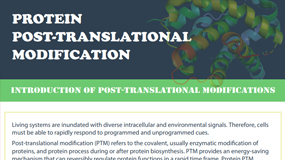- Service Details
- FAQ
Glycosylation mainly refers to the enzymatic process that attaches glycans to proteins, lipids, or other organic molecules. It is the most common protein post-translational modifications (PTM). Glycosylation analysis is challenging because of the complexity and the isobaric nature of attached glycans. With the increasing application of protein therapeutics, such as monoclonal antibodies, glycoproteins, hormones, cytokines and clotting factors in clinical practice, routinely monitoring the N-glycosylation of proteins gains popular.
 Figure 1. The different types of N-glycans produced in different organisms
Figure 1. The different types of N-glycans produced in different organisms
N-glycans are heterogeneously antennated oligosaccharide structures with a Man3-GlcNAc2 core. They are linked to the polypeptide chain via a glycosidic bond between the terminal N-acetyl glucosamine (GlcNAc) and the NH2 group of Asparagine. The aim of this set of complementary analysis is to elucidate the global N-glycan profile of a molecule of interest (such as proteins or peptides). Most of N-glycan sample preparation consists of the general steps including digestion of the glycoprotein, de-glycosylation, purification, labelling/ derivatization and SPE. Additional steps and technical options could also be used depending on the nature of the samples.
 Figure 2. The General workflow for N-glycans profiling
Figure 2. The General workflow for N-glycans profiling
N-Glycan Profiling Service
MALDI TOF MS and/or UHPLC based techniques determine the overall N-glycan population linked to a purified target molecule or a mixture of molecules.
1. N-Glycan profiling by MALDI-TOF MS
Qualitatively matrix-assisted laser desorption/ionization time-of-flight mass spectrometry (MALDI-TOF MS) represents high sensitivity and robustness for the structural characterization of glycosylated compounds and can also be used in a high-throughput manner. Single-charged ion formation maintained MALDI capability rather than electrospray ionization on profiling N-glycans mixtures. N-glycans released by enzymatic deglycosylation using Peptide N-glycosidase A or F is analyzed after permethylation.
 Figure 3. Example of N-Glycan structures detected and analyzed by using MS
Figure 3. Example of N-Glycan structures detected and analyzed by using MS
2. N-Glycan profiling by HILIC-UHPLC MS
Hydrophilic interaction chromatography (HILIC) has been a powerful technology for N-glycan profiling. So due to its wide acceptance, glycoprofiling of Enzymatic glycan release with PNGase F followed by derivatization by 2-aminobenzamide (2-AB) by HILIC-UHPLC is a fast and robust technique to analyze larger numbers of samples with well-known N-glycan profiles. Before fluorescent labelling, the harvested N-glycans should be further purified on a TSK Amide-80 column when large quantities of detergents, nonvolatile salts or materials with free amino groups are present which could interfere with the derivatization reaction. The labelled N-Glycans are then analyzed via HILIC separations combined mass spectrometric detection.
 Figure 4. The workflow for N-glycan profiling using HILIC column
Figure 4. The workflow for N-glycan profiling using HILIC column
Our N-Glycan Profiling Service
We can simultaneously identify glycosylation and other modifications that may coexist, and identify the interactions between different modifications.
Sample Requirements
| Sample Type | Animal tissue | Plant tissue | Blood sample | Serum | Urine | Cells | Yeast/microorganism |
|---|---|---|---|---|---|---|---|
| Sample volume | >1 g | >200 mg | >1 mL | >0.5 mL | >2 mL | >5×10^7 | >200 mg |
| Try to avoid the use of surfactants (SDS, Triton-X) and inorganic salts | |||||||
Service Content
- N-linked sugar analysis;
- Analysis of peptides containing N-glycosylation sites;
- Intact N-glycopeptide analysis
As one of the leading companies in the omics field with over years of experience in omics study, Creative Proteomics provides glycomics analysis service customized to your needs. Contact us to discuss your project.
How to place an order

*If your organization requires signing of a confidentiality agreement, please contact us by email.
Why do I need N-Glycan profiling?
Oligosaccharides play a crucial role in protein structure and biological activity. The occurrence and development of many human diseases are related to changes in the structure and expression of N-glycan chains on proteins. Therefore, the development and establishment of methods for analyzing N-glycans has positive and practical significance for biological and pathological research.
How can I analyze the N-glycosylation of my protein?
There are various methods, but we believe the most appropriate techniques are enzymatic release of N-glycans and fluorescent labeling. The polysaccharides are separated and quantified by HILIC chromatography and identified by MS/MS. In the case of overlapping peaks, the peak area is combined with the MS signal intensity to provide you with the most accurate relative quantification of each polysaccharide structure.




















